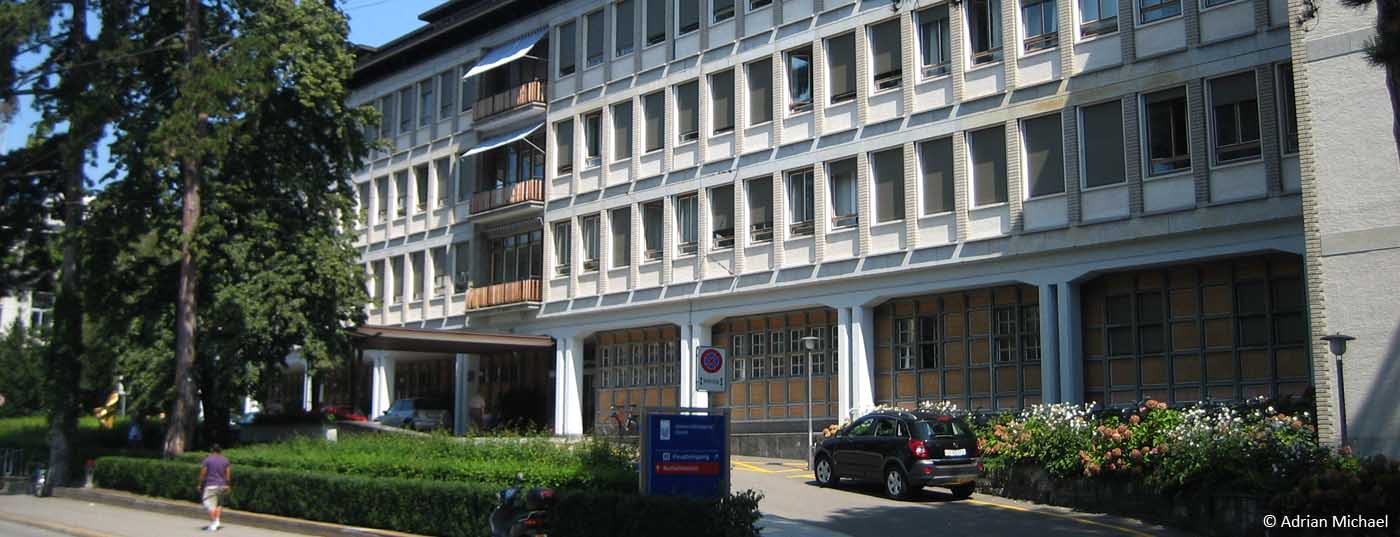What’s new in skin cancer therapy? An educational session at UniversitySpital Zurich focused on the options available to patients from improved immunotherapy and targeted treatments with BRAF and MEK inhibitors and viral approaches. Several new drugs offer hope and more are in the pipeline.
(ag) By way of introduction, Prof. Dr. med. Olivier Michielin from the University Hospital Lausanne gave an update on immunotherapy. First, he spoke about the clinical trial results of the CTLA-4 blocker ipilimumab (Yervoy®), a monoclonal antibody that indirectly increases the body’s T-cell activity and proliferation by means of binding to the protein CTLA-4 (“Cytotoxic T-Lymphocyte Antigen-4”), thus enhancing the immune response. Ipilimumab is approved for the treatment of advanced (unresectable or metastatic) melanoma in adults who have received prior therapy. “That intratumoral T-cell activity plays a role in prognosis in that it improves clinical outcome has already been shown by various studies, sometimes in advanced ovarian cancer [1],” the expert said.
In this sense, ipilimumab also developed a good clinical effect. Under therapy, a very good and, most importantly, stable plateau is achieved, which is still present more than three years after treatment (as illustrated by a pooled survival analysis of all phase I-III trials presented at the ESMO Congress 2013). “Accordingly, the body may remember the administration for a long time and the positive effect remains. Of course, the potential severity of side effects should not be underestimated. However, most of them are immune-related and reversible with appropriate timely treatment [2],” explained Prof. Michielin.
PD1 as target
Also an extremely promising new target is the PD1 receptor, the blockade of which leads to enhanced T-cell tumor defense. Two important studies were presented in this context at the 2013 ASCO Congress. One was a phase I trial testing a combination of the anti-PD1 antibody nivolumab plus ipilimumab in advanced melanoma [3]. “The two drugs seem to complement each other well. An impressive objective response rate of 53% was found at the maximum tolerated dose (1 mg/kgKG nivolumab, 3 mg/kgKG ipilimumab). All these patients achieved a tumor reduction of ≥80%,” Prof. Michielin explained. Side effects (mostly pruritus) also increased, but were not new and were well manageable and reversible within current guidelines. The cohort will therefore be further researched. “Nivolumab alone also offers better overall survival and works faster than ipilimumab. Here, it obviously depends on the dose,” Prof. Michielin said. Another PD1 antibody, namely pembrolizumab (formerly MK-3475), showed a very good response rate of 52% in advanced melanoma in a cohort with the maximum dose of 10 mg/kgKG every two weeks [4]. “The response comes very quickly and is pronounced. The 1-year overall survival also seems very good, more or less independent of dosing,” Prof. Michielin opined.
Updates on new drugs
Vemurafenib (Zelboraf®): Prof. Reinhard Dummer, MD, Deputy Chairman of the Board of Directors. Clinic Director of the Department of Dermatology at the University Hospital Zurich (USZ) and organizer of the event, gave a brief update on the BRAF serine-threonine kinase inhibitor vemurafenib. It is the “oldest” of the drugs presented here and remains the gold standard in BRAF-mutated melanoma. A key publication in this regard is the paper by Chapman et al. from 2011, which showed a benefit for both progression-free and overall survival in previously untreated melanoma patients with BRAF V600E mutation (compared to dacarbazine) [5]. Extended follow-up of this phase III trial [6] confirmed efficacy even in the rarer BRAF V600K mutation. Overall, it was clear that the benefit persisted in both mutation types and was still significantly higher compared to dacarbazine.
Replicating herpes viruses (T-VEC): “Serving the immune system something it actually wants to destroy” is how Prof. Dr. med. Mirjana Maiwald from the USZ described the so-called “oncolytic virotherapy” (OV), which uses the virus as a treatment method to specifically and effectively infect and destroy cancer cells. It is necessary to bypass host immunity and avoid damage to normal tissues at the same time. Herpes simplex, measles, and adenoviruses that are genetically and biochemically modified (e.g., the T-VEC virus, which was developed from herpes simplex 1 viruses) could be used. “Melanoma is relatively susceptible to viral therapy in this regard,” Prof. Maiwald explained. A randomized phase III trial of T-VEC (OPTIM) presented at ASCO 2013 had chosen as its primary endpoint the durable response rate, which was significantly increased with T-VEC in advanced melanoma patients (compared with GM-CSF). However, for overall survival, only a statistical trend towards superiority (compared to GM-CSF) has been found in studies to date.
Dabrafenib (Tafinlar®)/trametinib: According to Simone Goldinger, MD, USZ, several MEK inhibitors for the treatment of melanoma are currently in the pipeline or already approved (e.g. trametinib), but this does not yet apply to Switzerland. Particularly promising is the fact that MEK inhibitors appear to be effective not only in BRAF but also in NRAS mutations (e.g., binimetinib).
Dabrafenib is a potent and selective BRAF kinase inhibitor that has repeatedly demonstrated activity in adults with BRAF V600E-mutated metastatic or non-resectable melanoma (most recent results from BREAK-3). In combination with trametinib, progression-free survival again improved significantly compared to monotherapy, as shown in a 2012 study [7]. Among the side effects, the most notable was pyrexia, which occurred more frequently in the combination groups. In accordance with the hopes, fewer secondary skin tumors also formed under combination therapy.
“The main problem with kinase inhibitors is the development of resistance. It seems to be the price for the very rapid response and remission,” she said.
Vismodegib (Erivedge®): Med. pract. Mirjam Nägeli from the USZ spoke about Vismodegib, the first approved oral inhibitor of the Hedgehog pathway. It binds to SMO (smoothened) and has been approved in Switzerland for advanced basal cell carcinoma (BCC) since last year. A cost approval is mandatory. Vismodegib is also effective in metastatic BCC, a very rare form that usually originates from a large BCC on the head or neck. “In any case, the indication must be made on an interdisciplinary basis at a center. Patient education and support are essential,” says Dr. Nägeli. “Side effects are mild to moderate, but very limiting in quality of life (muscle spasms, alopecia, taste inhibition). All patients experience at least one of these side effects. With discontinuation of the drug, they are reversible. Last but not least, it must always be taken into account that vismodegib is teratogenic.”
Source: “Interdisciplinary Care of Skin Cancer Patients. Skin Cancer Therapy: New Drugs for the Clinician”, Continuing Education Event at the UniversitySpital Zurich, May 15, 2014, Zurich.
Literature:
- Zhang L, et al: Intratumoral T cells, recurrence, and survival in epithelial ovarian cancer. N Engl J Med 2003 Jan 16; 348(3): 203-213.
- Hodi FS, et al: Improved survival with ipilimumab in patients with metastatic melanoma. N Engl J Med 2010 Aug 19; 363(8): 711-723.
- Wolchok JD, et al: Nivolumab plus ipilimumab in advanced melanoma. N Engl J Med 2013; 369: 122-133.
- Hamid O, et al: Safety and Tumor Responses with Lambrolizumab (Anti-PD-1) in Melanoma. N Engl J Med 2013; 369: 134-144.
- Chapman PB, et al: Improved survival with vemurafenib in melanoma with BRAF V600E mutation. N Engl J Med 2011 Jun 30; 364(26): 2507-2516.
- McArthur GA, et al: Safety and efficacy of vemurafenib in BRAF(V600E) and BRAF(V600K) mutation-positive melanoma (BRIM-3): extended follow-up of a phase 3, randomised, open-label study. Lancet Oncol 2014 Mar; 15(3): 323-332.
- Flaherty KT, et al: Combined BRAF and MEK inhibition in melanoma with BRAF V600 mutations. N Engl J Med 2012 Nov; 367(18): 1694-1703.
DERMATOLOGIE PRAXIS 2014; 24(4): 34-34












